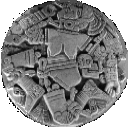
The Coyolxauhqui Stone

Image Credit: Moctezuma's Mexico-Visions of the Aztec World, by David Carrasco and Eduardo Matos Moctezuma. Published by University Press of Colorado, Niwot, CO, in 1992. From page 125.
Excavation of the Stone
The Coyolxauhqui Stone was discovered in the heart of Mexico City on
February 21, 1978, by workers employed by the Electric Light Company.
They suspended their work and contacted the Department of Salvage
Archaeology at INAH (Instituto Nacional de Antropologia e Historia).
Excavation revealed the 3.25 meter stone, a carved relief of a
dismembered female, to be a representation of the goddess Coyolxauhqui.
It was located at the base of the stairway of the Templo Mayor, on the
Huitzilopochtli side of the temple.
Artistic license was taken in placing the artifact that was found in the Stage IVb excavation into the corresponding place in this Stage VII VRML representation,
The story of Coyolxauhqui
The story of Coyolxauhqui is interlinked with with that of Coatlicue,
the mother goddess, and Hutzilopochtli, one of the primary patron gods
of Tenochtitlan. The story, recorded in the Florentine Codex, is
summarized briefly here. [1]
Coatlicue, the Mother of the Gods, was ritually sweeping a temple, and was impregnated by a falling ball of down. This event enraged her four hundred children, and they made preparations to attack her at sacred Serpent Mountain. These siblings were led by the female warrior Coyolxauhqui. Just before the mob of warriors reached the top of the mountain, Coatlicue gave birth to Huitzilopochtli ("Hummingbird on the Left"), a full-grown warrior. In the ensuing confrontation, Coyolxauhqui was decapitated, and her body rolled down the mountain, to lay dismembered at the bottom. Huitzilopochlti then triumphed over the remaining siblings, and lay claim to his title as God of War.
In Tenochtitlan, ritual sacrifice was performed at the top of the Templo Mayor, and the bodies of the victims were then rolled down the stairs, landing upon this stone. It is believed that the placement of the stone at the base of the stairs served to integrate ancient stories with the ritual in their own lives.